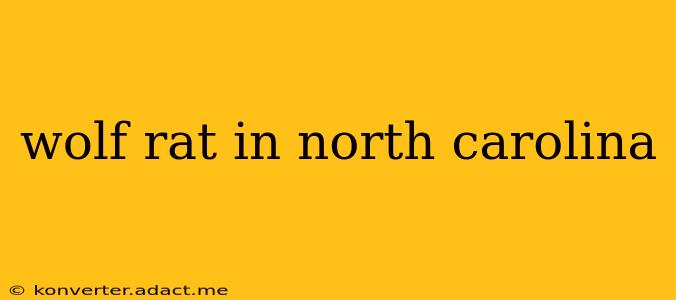The term "wolf rat" conjures images of a large, aggressive rodent, perhaps even something akin to a miniature wolf. While North Carolina does have a variety of rat species, the term "wolf rat" isn't a scientifically recognized classification. It's more likely a colloquialism, often used to describe particularly large or intimidating rats. This article will clarify what people likely mean when they use this term in the context of North Carolina, addressing common concerns and misconceptions.
What Rats are Commonly Mistaken for "Wolf Rats" in North Carolina?
Several rat species in North Carolina could be mistaken for the mythical "wolf rat." The most probable candidates include:
-
Norway Rats ( Rattus norvegicus): These are the largest rat species commonly found in North Carolina. They're robust, averaging 10-18 inches in length (including tail), and have a brownish-grey coat. Their size and aggressive behavior might lead people to call them "wolf rats."
-
Roof Rats (Rattus rattus): While smaller than Norway rats, roof rats are still sizable and can exhibit bold behavior, especially when cornered or defending their territory. Their slender build and dark coloration differ from Norway rats, but size alone might prompt the "wolf rat" description.
-
Cotton Rats (Sigmodon hispidus): These aren't true rats ( Rattus species) but are often confused with them due to their size and appearance. They're smaller than Norway rats but can still be quite large for a rodent. Their coloring is typically a grizzled brown.
Are "Wolf Rats" Dangerous?
The danger posed by any rat, regardless of size or nickname, stems primarily from the diseases they carry and the damage they can inflict on property. Both Norway and roof rats can spread diseases like leptospirosis, hantavirus, and salmonellosis through their droppings and urine. They also cause significant damage through gnawing on structures, wiring, and food supplies. While a large rat might appear more threatening due to its size, the disease risk remains the same.
How Common are Large Rats in North Carolina?
The prevalence of large rats, such as Norway rats, varies across North Carolina. Urban and suburban areas with ample food sources and shelter generally have higher populations. Rural areas are not immune, particularly near farms, food storage facilities, or areas with poor sanitation. The abundance of these larger rats, contributing to the "wolf rat" misconception, is directly related to human activity and the availability of resources.
What Should I Do if I See a Large Rat?
Never attempt to handle a rat yourself. Rats can bite, and bites can lead to serious infections. Instead, contact a professional pest control service. They have the expertise and equipment to safely and effectively remove the rodent and prevent future infestations.
What is the Best Way to Prevent Rat Infestations?
Preventing rat infestations begins with proper sanitation and eliminating food sources. This includes:
- Keeping food stored in sealed containers: This prevents rats from accessing easy meals.
- Cleaning up spills and crumbs immediately: Remove all attractants.
- Securing trash cans tightly: Prevent rats from accessing garbage.
- Repairing cracks and holes in your home's foundation and walls: Eliminate entry points.
- Keeping landscaping trimmed back from the house: Remove shelter areas.
By understanding the reality behind the "wolf rat" moniker and taking preventative measures, you can significantly reduce the risk of encountering these unwelcome guests in your North Carolina home or property. Remember, prevention is key!
